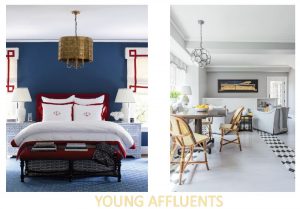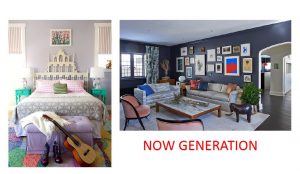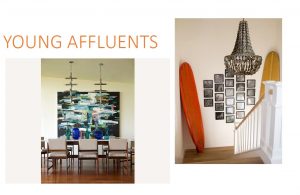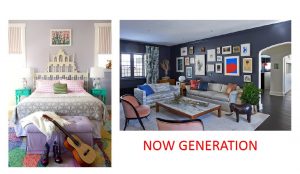DESIGNING FOR THE YOUNG AFFLUENTS
Posted by Member: Alan Kosa, Interior Designer


“Now” Generation
People who want instant gratification is becoming more prevalent in the late 20th and 21st century: Baby Boomers are the first Now Generation.
It’s a clear evolution in the behavior of consumers: they have become more impatient, they want replies to their questions as soon as possible, ideally right now.
People – and certainly the digital and mobile consumer- have less time and less patience indeed. I can feel it when I once again need to say “stop”. Your business feels it when customer service takes too long in an age where we want responses faster than ever and, unfortunately, instant gratification exceeds all limits. It is one of the consequences of the real-time economy and even a social phenomenon. And it reminds me of the lyrics of a song from the band, “Black Eyed Peas”.
They have this famous song called “Now Generation” which is full of words and brand names from the digital age: Google, MySpace, Facebook, Wi-Fi, podcast, iChat, SMS etc. The song also contains several strong sentences that describe really well what many people feel.
Such as: “I just can’t wait, I want it immediately cause time can’t wait and I sure can’t wait, I ain’t got no patience”. Or this: “Fast, rapido, really quick like torpedo, need for speed is my credo”.
Trends of Young Affluent Home Owners
- Young Affluents are tech savvy, fast responsive and grew up in a technical short attention span society. It’s all about texting, emailing, Instagram, Facebook postings and the latest app on line.
- Some clients inherited the home from their family including all of the furnishings
- Generation now still wants to combine Beauty, Function and Balance
- Designer needs to build trust with the do it yourself generation
- Typically this generation has no or little patience and they have a very short time frame to turn around a home
- This generation typically shops retail such as Restoration Hardware, Crate & Barrel and Pottery Barn. Much more a need it now product with little lead time
- Now Generation loves a homework assignment (Get them involved). They like to check things off of a list
- Love to describe their ideal home as chilled, friendly, comfy, child-friendly, groovy and easy.
- Budget – Typically unrealistic and want to accomplish way more than they count on financially
- Inheritance furniture needs to be reimaged and worked into interiors
- Clients will splurge on a few luxury items like a great carpet or a good quality sofa
- Sometimes kid’s art becomes the fine art in their homes
- Spread sheets help to force committing to a budget
- Designers are challenged for cost effective creative solutions like painting a floor instead of purchasing carpets
- Negotiating a design contract might include social medial endorsements and marketing such as twitter with a celebrity client
- Now Generation is typically intimidated by interior designers and architects. Designers need to establish a trusting relationship.
- Clients watch the DIY Network and HGTV thinking it is something they can easily do if only they had the time
- Now Generation is a spoiled generation. Husbands and most wives or partners usually both work. They are savvy and are successful in their business operations.
- Make it a point to always provide accurate bills, listen well and always, always deliver what you promise.
- Privacy is critical – keep all conversations between you and your client only
- Be diligent and thoughtful of your clients – Thank you messages and small token gifts are appreciated and lets the client know you are thinking of them.
- Keep the costs upfront and honest always. Make them clearly aware without surprises.
- The “Now” generation values real estate more than possessions. They want to pick up and go easily without too much to weigh them down
- Keep the relationship business like and not personal.
- Always listen to their needs first and foremost

LAYERING HISTORY – HYBRID DESIGN TODAY
Can Traditional Design have a contemporary spirit? Can contemporary design offer historical comforts?
Historically speaking – Home design is influenced by opportunity, times of crisis and Political upsets
MODERN STYLE – Optimistic
- Good things will happen in the future
- Example – Richard Meier Architect (Getty Museum), Frank Gehry Architect (Disney Center), Joseph Eichler (Architect of most California track housing developments post WWll.
TRADITIONAL STYLE – What clients want at a time of crisis.
- Design that is comfortable of the historical past. It’s part of our historical culture.
- Example – French Chateau, Colonial Design, Italian Renaissance style
TRANSITIONAL STYLE – Times of change
- A movement, development, or evolution from one form, stage, or style to another
- Political change relating to a current situation
- Example - introduces some touches of contemporary design while still keeping the familiar with traditional influences. Michael Graves Architect, Charles Gwathmey Architect, Cleaned up and functional design.
Today’s client considerations –
- Not looking to recreate the past but to move forward and reinvent the future
- A good architect must have understanding and knowledge of the history of the past but to be able to dissect it to make it contemporary for today’s lifestyle. Scale is important and this is only learned through study and education.
- Example – French Chateau never had master bedroom suites with upstairs master bathrooms
- Tuscan Architecture has been exhausted in California and now over. The new preferred style of affluence is “warm’ modern.
- Selectivity in decoration, scale, proportion created a contemporary home with a lot of hard work
- Architects and Interior Designers need to keep the client involved. Most clients enjoy the process.
- Chinese clients embrace traditional design such as French Chateau Style however want all of the elements of Feng-shui included. (Earthly elements of balance)
- Younger clients from 40 years and younger want it fun and a learning experience with a new attitude
- A home is “forever” and not a trend.
- Modern design can be cold so you need to be careful to add warmth to the interior.
- Traditional or classic homes can be modernized by art, nature and customization of the new hybrid style.
(Designing for today’s smart living and green inspired)
- First client consideration – How do you wish to live in your home? Floorplans are key as a first step.
- how does one move through a house
- Kitchens and closets are the new important spaces
- Good lighting unifies a home
- Materials and finishes are valued and make a home more modern
- Capturing the view is key to a home’s location
- Styles are blended in current times. The mix adds character
- Art is very important as many home owners are art collectors
- Always assure the scale of furniture is appropriate for the home
- Soft furnishings and lighting are easier then collecting object that can be assembled over years
- Classicism is a lost interest. The lack of historical design is a lost art and not taught in architecture
- Modernism is on a huge trend – example is that Georgian English antiques are not as collected with little interest. Instead Joseph Hoffman modern post war style furniture is of wide interest currently.
- Architect Richard Landry combines classic style homes with modern elements that embrace the view. Example – tearing down an old barn and repurposing the wood in a new context.
- Richard grew up near Montreal, Canada and was inspired by the many barns surrounding his family home
- Inspiration is architect/designer Paul Williams
- Interior Designer Steven Stills grew up in Oklahoma and was inspired by Billy Baldwin, Bill Blass and Francois Catroux (1970’s)

Alan is the owner of Alan Kosa Interiors, LLC
More information can be found on his website at: http://alankosainteriors.com/





